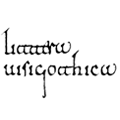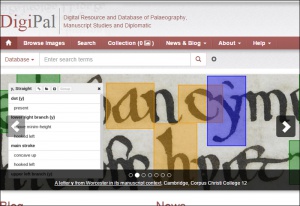VisigothicPal: when Visigothic script meets the DigiPal software
Here the official presentation of the project ViGOTHIC and the software VisigothicPal !!!!!
Tired of not being able to easily compare the graphic characteristics of a Visigothic script hand with other examples from the same graphic model? Annoyed about not knowing how to organise the hundreds of cuttings of letters and signs from Visigothic script hands you have collected over the years? Wondering how to share your research so other enthusiastic visigothicologists can understand your work and follow up with new discoveries? Wait no longer! VisigothicPal is here to help.
I am aware that most of you, dear readers, do not usually conduct palaeographic research on Visigothic script sources. But I am also aware that some of you work with Visigothic script codices and are concerned about the dates and production centres established for your manuscripts by current scholarship. Whether you are an art historian trying to figure out how an illumination program developed in a Visigothic script manuscript fits its artistic context, a musicologist examining how notation evolved in the early and high medieval Iberian Peninsula, or a historian looking at the dissemination of a particular work, you care about when and where your codex was written because your research builds on these details. You need to know these facts. Luckily, and I would like to think that maybe with a little help from this website, you will eventually find the information you were looking for. But what happens if you, seasoned expert but not visigothicologist, do not agree with what you find? Well, then you ask for help.
I am glad to say that over the last few months I have received some of these queries, thanks mostly to this site. These have included emails from colleagues asking if I could take a look at their sources and verify whether the date and place attributed is correct. After years of looking at Visigothic script sources, it is easy for me to recognise if a hand more likely corresponds to a 9th-century or to an 11th-century scribe, bearing in mind the evolution of the script. To determine whether the script is from the 11th or 12thcentury, or the location of its production centre, is rather more difficult. Palaeographers work by comparing a written sample with one or more others that can be placed and dated with certainty. As you know, charters do usually include a date and, by their text and context, tend to be easy to place geographically. Codices, on the other hand, usually lack this information. In fact, of the 352 identified codices in Visigothic script, only 49 have colophons stating the production centre in which they were written, the year and sometimes even the names of the authors involved. So, in order to set a place and date for a manuscript, how do we proceed?
There is no mystery in knowing how to carry out palaeographical research: collect the corpus you are interested in and relevant bibliographic references, set the methodology to be used, and apply it. If your corpus provides a date and place of origin, after your analysis you will have a set of standard features of the script employed at that time at that particular place. If only some of the sources from your corpus give that information, then in order to build their context a standard needs to be established first by analysing the sources placed and dated and then by contrasting their graphic characteristics with those sources lacking that information.
In any case, if your research is fruitful, you will end up having a specific set of features that correspond to a place and to a period of written production, and enough information to build up their cultural context. Now comes the tricky part. You will also end up having hundreds of trimmings. Have you figured out how to organise them in your printed article? You will more than likely present a general image of the source or sources, and then highlight particular features by including some small images of, for example, a g, a t, perhaps something about the wedged design of ascenders, some abbreviations, etc. That will be fine, although you are not sharing your full research, just what was relevant to you in that moment, and, thus, it will be a bit difficult for another researcher to reach the same conclusion. Now let’s imagine a couple of years have gone by since you did that research. Would you be able to open the folder, look at the hundreds of trimmings, and make sense of all that information? Moreover, would another researcher be able to do it if he or she wanted to continue your research? It happened to me and I can tell you that, no, you will not understand more than a small portion of all that you accomplished back then. So, what should we do?
For me, as I guess for all of you, it is crucial to be able to share our research with others and with our future selves. We cannot just pass along that folder with all our notes, unorganised, to someone who does not have the same mental process or the same level of experience as we had when we first started that specific research. I have a folder with thousands of cuttings of around 300 hands writing in Visigothic script in the north-western Iberian Peninsula I collected some five years ago. Every single time I feel I want to go back and do something with all that information because I know there is a lot that I can still do with it, I get a headache. I refuse to believe that there is no other way. Luckily, I am not the first one to think of that. Here comes help, here comes the DigiPal software.
I am sure that most of you, if not all, are aware of the existence of several digital tools that have been developed to help us carry out our research and share it with others. The software developed by the DigiPal project team at King’s College London is one of these tools. It is a programme created to help organise sources, work with them (marking), and build from them libraries of features neatly organised into several fields. No logarithm will do the work for you, you will need to do your manual work digitally. You will select what is relevant, given your expertise, for your research. And other people will be able to understand why it was relevant if you add notes when marking the manuscript, and to continue where you left off, or even to expand the research from their own point of view. It sounds amazing, but is it really?
I am a sceptic, but I am tired of always having the same problems when trying to organise and share my research. Thus, I want to test DigiPal by applying it to Visigothic script manuscript sources. Ta-dah! Project ViGOTHIC is born [official link].
by A. Castro
[edited 13/07/2018]

